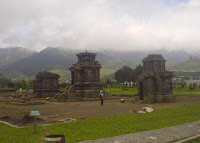It is located in the center of the city of Yogyakarta or just Yogya as the local people call it. Karaton means a place where the Ratu-king lives, other word is Kedaton, with the same meaning. In the Javanese teachings, it has a deep philosophical meaning.
The architect designer of this palace was Sultan Hamengkubuwono I himself, who was also the founder of the kingdom of NGAYOGYAKARTA HADININGRAT. His skill in architecture was appreciated by the dutch scientist - DR. Pigeund and DR. Adam who adored him as " the architect of his brother-Pakubuwono II of Surakarta".

The first king moved to his huge and magnificent Karaton on October 7, 1756. Although there are some European style of some parts of the building, structurally this is the vivid example of Javanese palace architecture.

The 14.000 sq. m of the Karaton Yogya has deep philosophical meaning with all its building, courts, carving, trees, and location. This is a Karaton full of significant symbols of human life.

Usually visitors are coming from MALIOBORO STREET, southward through the Alun-alun (north square). In order to understand perfectly well the symbolic meaning of the Karaton, one should walk from south to north. Start from Krapyak, a village of about 3 km south of Karaton.

Sunday, January 20, 2008
Famous Palace Of Yogyakarta
Posted by Webmaster at 11:40 PM 0 comments
Province: Yogyakarta
Thursday, January 17, 2008
Dieng Plateau Enchantment Tour
Early morning travel to Dieng Plateau (visit Dieng Plateau) via Wonosobo passing through the beautiful countryside and vegetable plantation. 

Arrive in Dieng Plateau (2090 m) enjoying the oldest Hindu temple complex in Java in elevation 6,000 feet and Si Kidang crater.

In the fourth day, we go to the highland of Dieng in Wonosobo. It's about an hour driving car. 

Unfortunately we couldn't make some pictures in our journey to Candi Dieng, Telaga Warna (colorful lake), Kawah Dieng, and Lake Menjer 
Dieng is a small tourist village with many guesthouses and small restaurants and shops. The Dieng Plateau was a marsh land but it has been partly drained. 

Some small temple ruins can be visited and there is also a small museum showing statues, pottery etc. that have been found in this area. But most interesting is a walk through the outskirts. At the Dieng Plateau there are still many active volcanos and the vulcanism can be felt everywhere! In the south of the Bima temple you can see cooking brooks, boiling pools of mud, hot springs
Posted by Webmaster at 7:24 PM 0 comments
Province: Central Java

